
Rīgas Satiksme (Riga municipality public transportation) achieves significant cost and carbon savings with Papercast e-paper
Rīgas Satiksme is further enhancing the travel experience for Riga’s Public transport users with the second…

Welcome to the fourth in a series of blogs where we tackle the big questions we hear when we first discuss Papercast® as a solution. We started with energy efficiency and followed up with extreme climates and power supply options, here we look at the accessibility credentials of our solution.
At Papercast, we believe that public spaces, amenities and services should mean just that – they are meant for everyone. Around 15% of the world’s population suffers from a disability, and so it is essential that accessibility requirements are factored into their design.
Mobility is a critical component in the accessibility agenda – people with all levels of abilities need to reach these destinations using public transport that is inclusive and accessible. In fact, the UITP cites mobility as a key factor for economic and social integration and is one of the most important issues facing public transport nowadays.
With a desire to provide the best possible service for every customer, the industry is firmly behind transport accessibility. This means providing fully accessible public transport services that are easy to use, and why we are often asked about Papercast’s credentials in this regard.
We have designed our e-paper passenger information displays with the user in mind, making sure our solution is as intuitive, accessible and safe as possible. We also keep track of accessibility legislation around the world and develop our functionality to meet the world’s most stringent regulations and standards.
By making provisions for people with mobility issues, audio or visual impairment, our e-paper displays are available with the following features and functionality. In all cases, we recommend that the accessibility elements are consistent for every display type so that users become familiar with them at all bus stops.
1. E-Paper Readability
E-paper displays are high resolution and high contrast, which means the content is very clear and easy to read in all lighting conditions (with illumination in the dark). This is ideal for people who are visually impaired. Additionally, e-paper has an exceptionally wide viewing angle of 175 degrees which means that mobility aid users will be able to see the screen content if they are in a seated position.
2. Display Installation
Papercast displays can be installed on a pole, wall or shelter at a height that meets any prescribed reach ranges to the accessible interactive controls, such as the push-to-talk button. Our displays can also be located to meet all required viewing positions.
3. Content Customization
The Papercast Content Management System (CMS) enables complete control over the display content. You can customize information to ensure readable font styles, depending on the height from the ground and horizontal viewing distance from the user. We support san serif fonts without italic, oblique, script or decorative fonts, and offer full control over sizing and spacing as well as character limits where relevant.
4. Interactivity
Up to four optional display control buttons allow the user to interact dynamically with the on-screen content. As well as browsing a wide range of travel information, the buttons can be used to control illumination, play recorded announcements or activate text-to-speech. Papercast can interface with externally mounted Americans with Disabilities Act (ADA) approved buttons to trigger the TTS or other functions.
5. Text-to-speech
Papercast e-paper displays support text-to-speech (TTS) functionality using software that verbally announces essential information at the customer’s request. High-quality audio supports multiple major languages and delivers a human-like, engaging and personalised user experience. You can define what text can be converted to speech in the content management system, including:
Audio is delivered via embedded loudspeakers with an integrated amplifier and can be activated by pressing a push-to-talk button on the display. Alternatively, an external speaker controlled via a push-button station connected to the display device can be used.
6. Audio Stations
An Audible Push Button Station (APBS) can be integrated with the displays to provide an audible message when activated and assist as a wayfinding announcement system.
7. Hearing Loop System
TTS and audio stations can be enhanced with a hearing loop sound system to assist people with hearing aids. The hearing loop provides a magnetic, wireless signal that is picked up by the hearing aid when it is set to ‘T’ (Telecoil) setting.
8. Beacons
Papercast e-paper displays can be fitted with proprietary beacons that use low-energy Bluetooth technology to send signals to nearby smart devices. This interface is primarily used to support those with disabilities and can provide travel information directly to passenger designated assistant devices. A QR code application is also available to synch display content with the user’s device.
9. Braille
We offer braille engraving or labelling on display buttons.
10. Content Management System
Passengers may well be the primary user of the Papercast e-paper displays, but we also need to consider the users of the CMS. The graphical user interface follows contemporary responsive website design principles as well as guidelines for accessibility for people with disabilities. All pages and most of the CMS functionality comply with Web Content Accessibility Guidelines 2.1 to level AA as a minimum. The platform has been developed using HTML 5 and marked semantically according to best practices.
For custom components, the Web Accessibility Initiative – Accessible Rich Internet Applications (WAI-ARIA) tags are used to provide a good experience for screen reader users (visually impaired, users with loss of vision or users with learning disability).
For visually impaired users, there’s adequate contrast between text and background (WCAG 2.1 AA compliance at minimum) and we comply with other guidelines, such as not using colour alone to convey meaning. Responsive web design also ensures that users can enlarge the text size (use the page at different zoom levels) without any loss of functionality or worsening the experience.
Papercast’s engineering team is constantly developing our technology to ensure it continues to keep passengers more reliably informed, providing easy access to public transport for every passenger! We are also able to provide bespoke functionality to meet specific authority or regulatory requirements.
If you would like further information on how the Papercast e-paper passenger information display system can meet your accessibility goals, please get in contact.

Rīgas Satiksme is further enhancing the travel experience for Riga’s Public transport users with the second…

Papercast’s solar and battery-powered e-paper displays are built to last, even in the harshest of…